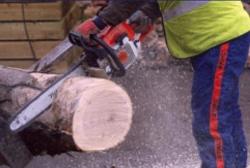Timber Work
One of the most dangerous tasks carried out on farms is felling trees and using chainsaws.
|
 |
Using the chainsaw
- Ensure the chainsaw is properly maintained
- Make sure you know where the controls are, and that they are all in working order
- To prepare to start the engine, hold the saw firmly in position on level ground
- Apply the chain brake when the chainsaw is not in use
- Shut off the engine before moving from one area to another
- Never leave the chainsaw unattended while it is idling
- Never use the chainsaw above shoulder height or when you are off balance
Avoiding kickback
- Make sure that the chain and chainsaw are adequately maintained
- Never begin cutting with the upper half of the nose of the blade. While cutting, watch out for branches, logs or other material that could come into contact with the danger zone
- Grip the saw properly, using both hands. The thumb of the left hand should be under the handle
- Before cutting, your left arm should be straight. In the event of kickback, this will help to divert the saw over your body
- Never run the engine slowly at the start or during cutting, as this can lead to kickback
Work area precautions
|
 |
Felling trees
- Make sure the chainsaw operator has the necessary training
- Consider factors such as the wind, the natural lean and balance of the tree, location of large limbs, and whether the trunk is sound, hollow or partially rotted
- Watch out for dead limbs overhead and for overhead power lines
- Make sure that bystanders are at a safe distance
- Watch out for 'spring poles' or conditions where a log or tree is under tension



